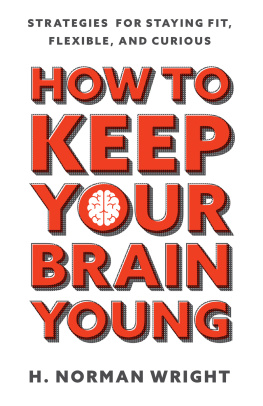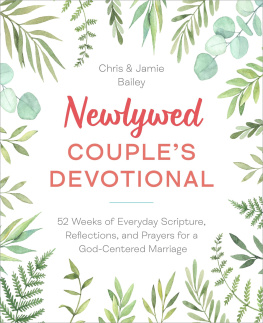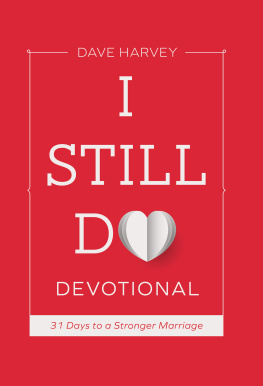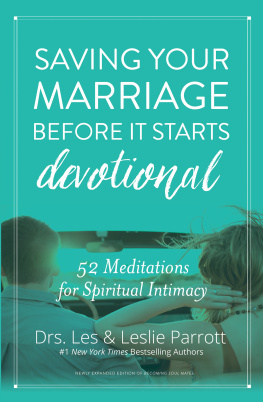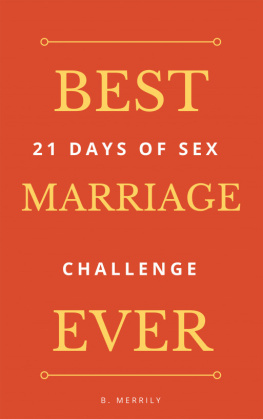
Unless otherwise indicated, all Scripture quotations are taken from the Holy Bible, New International Version. NIV, Copyright 1973, 1978, 1984 by the International Bible Society. Used by permission of Zondervan Publishing House. The NIV and New International Version trademarks are registered in the United States Patent and Trademark Office by International Bible Society.
Scripture quotations marked AMP are taken from The Amplified Bible, Old Testament, Copyright 1965 and 1987 by The Zondervan Corporation, and from The Amplified New Testament, Copyright 1954, 1958, 1987 by The Lockman Foundation. Used by permission. All bracketed material is from the original.
Scripture quotations marked NASB are taken from the New American Standard Bible, 1960, 1962, 1963, 1968, 1971, 1972, 1973, 1975, 1977 by The Lockman Foundation; or from the New American Standard Bible, 1960, 1962, 1963, 1968, 1971, 1972, 1973, 1975, 1977, 1995 by The Lockman Foundation. Used by permission.
Scripture quotations marked TLB are taken from The Living Bible, Copyright 1971 owned by assignment by Illinois Regional Bank N.A. (as trustee). Used by permission of Tyndale House Publishers, Inc., Wheaton, Illinois 60189. All rights reserved.
Scripture quotations marked RSV are taken from the Revised Standard Version of the Bible, Copyright 1946, 1952, 1971 by the division of Christian Education of the National Council of the Churches of Christ in the U.S.A. Used by permission.
Scripture quotations marked MSG are taken from The Message. Copyright 1993, 1994, 1995, 1996. Used by permission of NavPress Publishing Group.
Verses marked KJV are taken from the King James Version of the Bible.
Scripture quotations marked PHILLIPS are taken from J.B. Phillips: The New Testament in Modern English, Revised Edition. J.B. Phillips 1958, 1960, 1972. Used by permission of Macmillan Publishing Company.
Verses marked NLT are taken from the Holy Bible, New Living Translation, copyright 1996. Used by permission of Tyndale House Publishers, Inc., Wheaton, Illinois 60189, U.S.A. All rights reserved.
Cover by Terry Dugan Design, Minneapolis, Minnesota
AFTER YOU SAY I DO DEVOTIONAL
(formerly Together for Good)
Copyright 2000 by H. Norman Wright
Published by Harvest House Publishers
Eugene, Oregon 97402
Library of Congress Cataloging-in-Publication Data
Wright, H. Norman
After you say I do devotional / H. Norman Wright
p. cm.
ISBN 0-7369-0981-8
1. Marriage. 2. MarriageReligious aspectsChristianity. I. Title.
HQ734.W94973 2000
306.81dc21 00-024151
All rights reserved. No part of this publication may be reproduced, stored in a retrieval system, or transmitted in any form or by any meanselectronic, mechanical, digital, photocopy, recording, or any otherexcept for brief quotations in printed reviews, without the prior permission of the publisher.
Printed in the United States of America.
02 03 04 05 06 07 08 / DP-MS / 10 9 8 7 6 5 4 3 2 1
Contents
So they are no longer two, but one.
Therefore what God has joined together,
let man not separate.
MATTHEW 19:6
W hat is your favorite part of a wedding ceremony? Is it the processional? The giving of the bride? The reading of the Scriptures? Saying the I dos? The exchange of vows? The pronouncement of husband and wife? Is it when the bride and groom kiss? What about the ring exchange?
This ring I give you, as a symbol and pledge of my constant and abiding love.
symbol n.: Something representing something else by association, especially a material object representing something abstract.
pledge n.: A solemn promise to do or not do something.
Every part of the wedding ceremony has a purpose. The ring exchange tangibly symbolizes the vows we make. The next day, the rings provide the only visible evidence that a wedding ever took place. The rings say to the watching world that each person has taken a vow, that a pledge has been made:
Will you have __________ to be your wedded (wife/husband) to live with (her/him) after Gods commandments in the holy state of marriage, and will you love, honor, and cherish (her/him) so long as you both shall live?
Some people use rings for decoration. Some use rings to communicate status. Others to show wealth. Wedding rings speak of commitment. When a husband or wife wears a wedding ring, he or she tells the world, I am committed to a person. I have given my life to this person. This person has pledged to love, honor, and cherish me for the rest of our lives together. This person has taken a vow to be faithful, and I, in return, have also vowed to be loving and faithful. This ring is a symbol of love and affection given and received.
Do you remember the vows, pledges, and professions you made on your wedding day? If not, find them and reread them. It will be a great time of renewal.
For this reason a man will leave his father
and mother and be united to his wife,
and the two will become one flesh.
EPHESIANS 5:31
oneness n.: 1. The state or quality of being one. 2. Uniqueness: singularity. 3. The condition of being undivided: wholeness. 4. Sameness of character. 5. Agreement: unison.
O neness captures in a single, pregnant word the overarching goal of a Christian marriage. Oneness marks the summit of marital union. It is the peak toward which we climb. It summarizes scriptural teaching on marriage: The two will become one.
Oneness is a state of harmony in which the husband and wife lovingly meet each others needs and fulfill Gods purpose for their marriage. Oneness is to make a third entity of two who forsake themselves for each other. It is symbolized by the formula engraved on my wedding band: 1 + 1 = 1. Oneness means that through everything well be one.
How can two distinct people from two distinct backgrounds with two different sets of needs, priorities, drives, and motivations make one life together? The difference between a great marriage and a poor marriage is the degree to which each partner is willing to meet the appropriate needs of the other. The secret of oneness lies in the biblical command to deny ourselves, take up our cross, and follow Jesus. To really love someoneanyonerequires denial of self and surrendering ourselves for another. Compromises must be made. Unless we have our cross in hand, these self-denials, sacrifices, and give-and-takes create resentment and bitterness.
When both the husband and wife are committed to sacrificially loving and serving the other, a fantastic onenessbecoming one fleshoccurs.
Have you ever really said, I will give up what I want to meet the needs of my life mate?
But God demonstrates His own love toward us,
in that while we were yet sinners, Christ died for us.
ROMANS 5:8 NASB
When two people get married, they have expectations of how the relationship should work. Often the unspoken assumption is that my spouse will meet me halfway. Sometimes its called the 50/50 Plan. When the husband and wife operate on this pattern, its easy for it to spread to other members of the family.
T he 50/50 Plan says, You do your part, and Ill do mine. It sounds logical, but couples who use it may be surprised.
A young man saw an elderly couple sitting down to lunch at McDonalds. He noticed that they had ordered one meal and an extra drink cup. As he watched, the gentleman carefully divided the hamburger in half, then counted out the fries, one for him, one for her, until each had half of them. Then he poured half of the soft drink into the extra cup and set that in front of his wife. The old man then began to eat, and his wife sat watching, with her hands folded in her lap. The young man decided to ask if they would allow him to purchase another meal for them so that they didnt have to split theirs.
Next page


